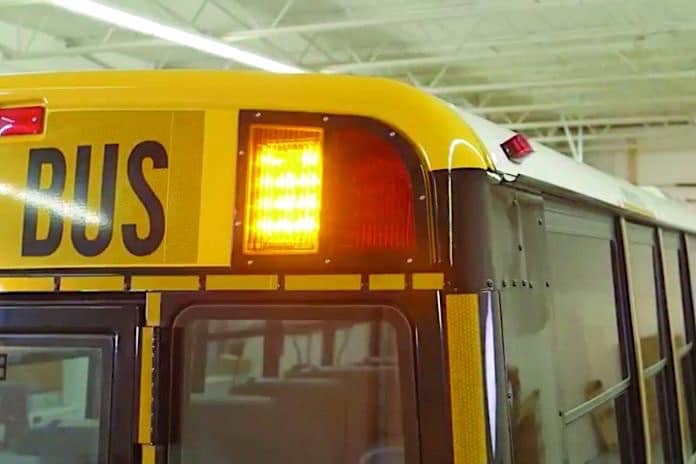A pilot project underway at Marietta City Schools for the past two months has been testing the efficacy of additional LED lights installed on the front and rear bumper to call motorist attention to school bus stops.
Kimberly Ellis, who succeeded the retired Mark Lindstrom as the district’s transportation director earlier this year, explained that the UltraLED lighting system works in conjunction with the school bus eight-way lights and the stop arm during student loading and unloading.
“It’s just an extra measure to keep our students safe and to make our public aware that the school bus is stopped and they don’t need to pass it,” she said.
This month, she added that enough data should be in to decide on how to proceed, namely if the LED system is destined eventually for the remainder of Marietta City’s fleet. That will depend on if the district’s stop-arm video managed by American Traffic System and captured on both Angeltrax and REI cameras shows a marked decrease in the number of illegal passing incidents on the pilot bus.
“If we show lower violations, we’ll do everything we possibly can to get the LEDs on all our buses,” she added.
Increasingly, student transporters nationwide are turning to LEDs to increase visibility and safety on and around their school buses. This month’s survey indicates that more than two-thirds of readers are choosing LEDs over traditional incandescent lights, so said the 366 respondents with the title of transportation director or supervisor for their local operations. One of those is Glenn Sykes. The director of transportation for Alamosa School District RE-11J in south-central Colorado just east of the Rio Grande National Forest said he and other local student transporters are especially specifying LEDs for the rear of the school bus to increase visibility. Alamosa recent ordered LEDs pre-installed on its new school bus vehicles in response to a rear-end collision.
“The old incandescent (lights) were so difficult to see in the afternoon sun,” he said of the incident, in which another vehicle slammed into the back of one of his buses. “After talking to the people involved and other districts seeing a large drop in rear ends because of LEDs, we decided that they are a must for us.”
He said the initial incremental purchase price of LEDs is the only issue giving him pause in extending LEDs throughout his entire fleet. “Our state does a partial reimbursement for them but they are still expensive.”
According to Colorado state administrative rules for the public school transportation fund, districts like Alamosa are reimbursed for “alterations” to school buses, such as the addition of LEDs, as long as the equipment results in an “increase in efficiency and safety or are necessary to meet minimum standards.” School districts must own the school buses sfor at least three years and the LEDs must be an upgrade from standard incandescent lights.
Despite any delay in covering the initial cost, Sykes said LEDs are worth every penny.
“I absolutely believe they are worth the investment in the long run, (it’s) just much easier when purchasing (new) as opposed to retrofitting,” he added. “There is only one downfall to LEDs that I have noticed over the years both on buses and personal equipment, and that is the lack of heat produced to help with snow melting during winter driving months. Most of them are bright enough they still shine through, but we do get wet snow that builds thick enough to possibly create a problem.”
LEDs, by nature, are designed to emit light at lower temperatures, which is why they last longer than traditional incandescent lights, require less maintenance and save money in the long run. But the brightness, or in this case electro-luminescence, of LEDs is more than adequate to bring attention to the school bus at stops. Dozens of STN survey respondents specifically cited increased visibility and brightness as benefits.
Seneca R-7 School District in southwestern Missouri experienced this firsthand after moving to LEDs two years ago when bus stops along State Highway 43 became even more challenging with a posted speed limit increase to 65 mph. Transportation Director Eric Smith said the originally district tried a host of remedies, from altering routes to retraining students on where to wait for the bus, and pulling into neighbors driveways for loading and unloading to allowing school bus drivers to turn on the yellow warning lights at 65 mph rather than 45 mph.
“All of these implementations helped the safety of the students but didn’t decrease the number of stop sign violations that we were having happen up to two times a day,” said Smith.
But since the transition to LEDs from incandescent lights, Smith said the decrease in fly-bys fell to one per week and most recently maybe one a month.
Reprinted from the May 2017 issue of School Transportation News magazine.


















